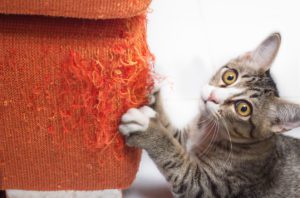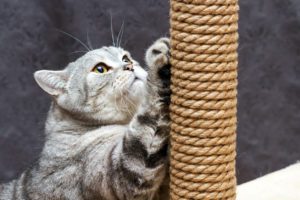Cat owners can live peacefully with their clawed cats and avoid damage the cat might cause on the furniture or curtains by understanding how cats behave and by filling your home with items that can be used by them for scratching. Many owners believe that declawing (onychetomy) can stop their cats’ scratching behavior. While declawing is a surgical amputation that will remove the claws and therefore prevent scratching, it does not stop your cats desire to scratch, which is an important, normal feline behavior. Read on to learn ways to prevent your cat from scratching your furniture and direct their scratching toward acceptable objects.

Why Do Cats Have Claws?
Domestic cats have followed the line of maintaining their hunting instincts like their wild ancestors. Cats are very physical and use their claws for several functions. The claws on the forelimb are retractable and allow them to expose or retract their claws if necessary.
Cats use their claws to hunt and capture prey, to fight and defend themselves when they experience conflict with other animals and to scratch and mark items in their territory, similar to what wild cats do.
Why Do Cat’s Scratch?
Understanding the reason why cats scratch can help cat owners to direct their pets to scratching the proper object. Scratching is a normal, necessary and natural behavior for your cats and they do it for many reasons.
Cats need to scratch because it is a fundamental part of their nature. Scratching helps groom the nails, stretches the muscles and flexes the claw-retracting apparatus. Scratching can also be used as a form of communication for cats, particularly as way of marking their territory. They leave visible marks and scents from glands on their paws to signal to other animals.
Stress and anxiety can cause an increase in scratching and marking, which happens when environmental resources are restricted or threatened. It is important to identify the cause of the stress and anxiety and address these issues to reduce unwanted scratching behavior. If you need more assistance, visit your veterinarian who can help identify ways to help decrease your cat’s stress level.

Tips for living with a clawed cat:
- Trim your cat’s nails. If unsure how to trim your cat’s nails, visit your veterinarian for demonstrations. Temporary synthetic nail caps can be used as another options for some cats.
- Provide appropriate resources for the cat. These resources include:
- Food bowls
- Toys to play and be distracted
- Clean Litter boxes
- Water bowls
- Sleeping and resting areas
- Scratching surfaces (with a variety of textures)
- Provide useful and safe environmental enrichment in your home. This can include daily interactive play as well as scratching and perching locations that allow access to vertical space.
- Friends and family should be educated on how to interact with cats. They should not handle the cat is a way that can cause stress, fear or discomfort.
- Attend any inter-cat related issues that may be causing the cats any anxiety or fear. Inter-cat issues are common and can be easy to miss or misunderstand. One way to avoid conflict between cats is to place resources (litter box, food, water, resting places) in multiple places throughout the house to avoid competition for resources. This also helps your cat easily escape if they feel threatened or stressed.
- Do not use toes or fingers, or shaking your feet or hands, to play with your cat, as it can teach your cat that biting and scratching is an acceptable way to interact with their people. Instead, use toys that stimulate their hunting instincts and schedule time daily for interactive play using appropriate toys.
Give Cats Inanimate Objects to Scratch
Cats have their own preferences as to the type and placement of scratching surfaces. The perfect type of scratching post is the type your cat enjoys best. You might need to offer your cat a variety of scratching posts to find what kind they like. Here are some general tips you need to know about positioning your scratching post:
- Providing multiple posts in different locations. If you cat has been scratching on a piece of furniture, put a post next to it and reward them with play, praise or treats when they use the post. It is also good to place a post next to where they spend time resting or sleeping.
- The scratching post must be stable, so when they scratch it or jump on it, it won’t wobble and fall over.
- Most cats enjoy using sisal as a scratching surface. Other preferences are bark, rough fabrics, corrugated cardboard and carpets.
- Most cats enjoy vertically placed scratching posts but there are also some cats that enjoy scratching horizontally. If your cat enjoys scratching table legs or other vertical parts of furniture, then they probably enjoy scratching vertically. If they like to scratch carpets or floors, then they probably enjoys scratching horizontally.
- The scratching post should be tall enough for your cat to stretch their full body.

How to Encourage Your Cat to the Scratching Post
To encourage your cat to use the scratching post and slowly stop them from damaging more properties, try these ideas:
- Dangle one of their favorite toys from the post. This would lure them and make them want to jump on the post.
- Reward your cat with treats, petting, praise or food whenever they use the scratching post.
- Apply catnip to the post.
Conclusion
Remember that cats need to scratch as a part of their normal behavior. If they can’t fill that need it can cause stress and frustration which can lead to other undesirable behaviors. If your cat is suddenly scratching more it probably means they are stressed. If this happens contact our veterinarian to help identify any medical or behavioral stress.
